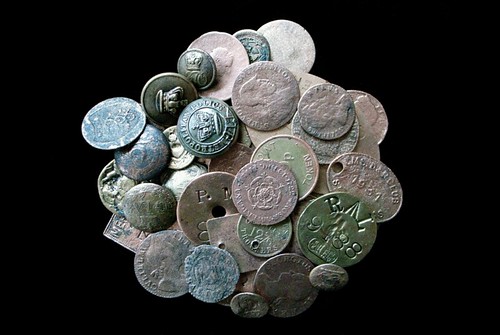
PREV ARTICLE
NEXT ARTICLE
FULL ISSUE
PREV FULL ISSUE
ARTICLE DISCUSSES THAMES RIVER NUMISMATIC FINDS
Art Daily published a Reuters article this week about the "mudlarks" who explore the banks of the River Thames in London. Quite a variety of numismatic items have surfaced over the years.
-Editor
As the tide ebbs exposing the shore, Steve Brooker casually tosses a 17th century trader's token he has found in the dirt into his bucket. "Remember it's all about getting your eye in," says Brooker, who, armed with little more than a trowel, gloves, obligatory boots and an infectious enthusiasm has been combing the foreshore for antiquities for the past 20 years. Traders' tokens were issued by local merchants during and after the English Civil War (1642-1651) as a form of small change at a time when lower denominations of the realm were out of circulation. Preserved by the oxygen-free mud, the tiny copper-alloy farthing bears the name Thomas Lowe of Three Nuns Alley. The other side of the coin is stamped with the figures of three nuns and is later traced to a merchant's house in a long-lost narrow lane that now lies buried deep somewhere beneath Threadneedle Street, home to the Bank of England.

"You can smell the history down here -- it's everywhere," he says as we disappear from view for a guided tour under the cavernous quay supports of Old Billingsgate Fish Market, an ancient place associated with the trade of all manner of goods, including seafood, since medieval times. Brooker, 49, a larger than life character -- he is 6 feet 6 inches tall -- is no ordinary beachcomber however. He is one of only 45 members of the Society of Thames Mudlarks who are licensed by the Port of London Authority to search the northern shore between Westminster, the seat of government, in the west of the old city and the Tower of London in the east. Anyone can walk the length of the capital's exposed shore at low tide but only mudlarks, who diligently record their finds with the museums, can excavate the archaeologically rich north bank. Members of the public can give it a go too, so long as they buy a permit, but they are only allowed to search to a depth of a few inches on the southern shore and, like mudlarks, must report anything over 300 years of age. Discoveries are returned to the finder once they have been photographed and the find spot revealed. The Thames has been settled for millennia and the range of items it continues to yield is testament to its rich past. Prehistoric and Celtic tribes as well as Roman, Saxon, Viking and Norman occupiers have all graced its slippery banks and left their indelible mark. Kate Sumnall, an archaeologist and Finds Liaison Officer with the Museum of London who is charged with identifying mudlark finds says their work is "phenomenally important." "They have made a huge contribution by donating artefacts to us, but also in terms of the knowledge they bring because they have been showing us their finds for such a long time -- I often learn from them," she told Reuters. "The medieval toys and pilgrim badges (they have found) are two of the key collections where their contributions have really helped change archaeological interpretation of the past." Pewter pilgrim badges, 13th century keepsakes gathered by our god-fearing ancestors from religious shrines that dotted the land, are a mudlark's favorite. Brooker has scooped up thousands of artefacts from the mud over the years, and along with his peers, has recorded many historically important finds with the London and British Museum. His own collection includes Tudor daggers, opulent 18th century Georgian century shoe buckles, ornate medieval broaches and coins from almost every realm. He has even plucked tiny pairs of perfectly preserved leather shoes from the mud that once belonged to Roman children. Many finds are displayed on his website: http://thamesandfield.com/. In 2009 he made world headlines when he discovered an iron ball and chain deep in the mud. The leg irons, thought to be 300 years old, still had the lock fastened, suggesting a convict may have drowned while trying to escape its grasp. Since then he has drawn considerable media interest, and has just finished filming an eight-part series called "Mud Men" for the international satellite channel History, formerly the History Channel which began in Britain on Monday. In the show, dubbed "guerrilla archaeology" by the makers, a mud-spattered Brooker teams up with British radio presenter and foreshore novice Johnny Vaughan to unravel the story behind every discovery they make. The unlikely pairing makes for compelling viewing as they explore the quirkier side of English history, sometimes with hilarious results. Experts are on hand to help with identification and give insights into each era. "It's about educating people about the past and what's out there and getting them involved -- It's archaeology for everyone," says Brooker who eventually wants to open his own foreshore museum close to the river.
To read the complete article, see:
For the Past 20 Years London's Society of Mudlarks Retrieve History from the Thames
(www.artdaily.org/index.asp?int_sec=2&int_new=45451)
The Numismatic Bibliomania Society is a non-profit organization promoting numismatic literature. See our web site at coinbooks.org. To submit items for publication in The E-Sylum, write to the Editor at this address: whomren@gmail.com To subscribe go to: https://my.binhost.com/lists/listinfo/esylum All Rights Reserved. NBS Home Page Contact the NBS webmaster 
|
